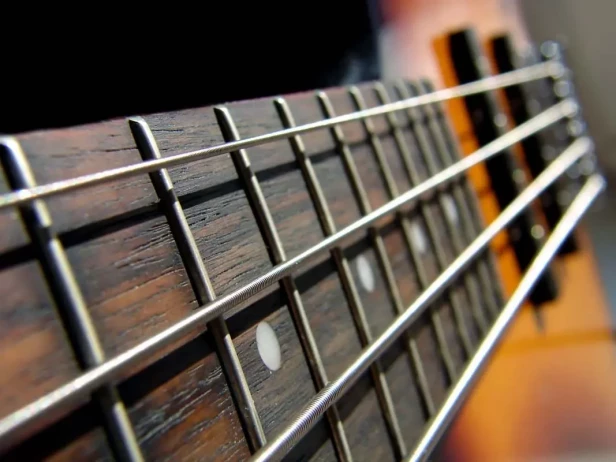What Is a Bass Guitar?

by:guitarnews
What Is a Bass Guitar?
A bass guitar is a plucked string instrument built in the style of an electric guitar but producing lower frequencies. It produces sound when its metal bass strings vibrate over one or more magnetic pickups (although non-magnetic pickups are occasionally used as well). The pickups then transmit a signal, via instrument cable, into an amplifier, which allows the bass to be heard at a wide range of volumes.
How Many Strings Does a Bass Guitar Have?
The majority of bass guitars have four strings, but five-string, six-string, seven-string, and eight-string models are favored by certain players. A four-string bass is traditionally tuned in 4ths (much like guitar strings), with specific tunings as follows:
- 1. The highest (or 1st) string is tuned to G2 and is called the G string
- 2. The 2nd string is tuned to D2 is called the D string
- 3. The 3rd string is tuned to A1 and is called the A string
- 4. The lowest (or 4th) string is tuned to E1 and is called the E string
- 5. If a bass has a 5th string, it’s typically to add lower pitches, and it’s tuned to B0
- 6. If a bass has a 6th string, it’s usually higher and is tuned to C3
What Are the Different Types of Bass Guitars?
The electric bass dates back to 1935 when the Audiovox corporation produced its Model 736 Bass Fiddle. The Model 736 was immediately differentiated from traditional double-basses by including frets on its neck. This made intonation far easier, which made bass playing accessible to a wider array of players.
The bass guitar as we know it was first produced by the Fender Electric Instrument Manufacturing Company in 1951. Known as the Precision Bass (or “P-Bass,” as it is now called), it was modeled on Fender’s popular Telecaster electric guitar. Although it has gone through minor modifications over the decades, the P-Bass remains popular. Some of its most notable players include:
- 1. Motown legend James Jamerson
- 2. Stax Records house bassist Donald “Duck” Dunn
- 3. Session ace Carol Kaye
- 4. Early Santana bassist David Brown, whose P-Bass was featured at Woodstock
- 5. Pink Floyd songwriter/conceptual leader Roger Waters
- 6. Iron Maiden bass guitarist and chief songwriter Steve Harris
- 7. Queen bassist John Deacon
Fender is also noted for its Jazz Bass, which was first introduced in 1960. It was designed to emphasize the middle and upper registers of bass playing (whereas the P-bass was known for its low end). It was modeled on the Jazzmaster electric guitar, although both the Jazzmaster and Jazz Bass seemed to catch on more with rock players than jazz players. Some of the notable Jazz Bass players include:
- 1. Jazz, rock, and fusion wunderkind Jaco Pastorius, who was particularly known for playing fretless models of the Jazz Bass
- 2. Red Hot Chili Peppers bassist Flea
- 3. U2 bassist Adam Clayton
- 4. Rush singer/songwriter Geddy Lee
- 5. Tim Commerford (aka Timmy C) of Rage Against The Machine
What Are Some Examples of Famous Musicians Who Played Bass Guitar?
There are many famous bassists throughout the history of music. Most are associated with particular instruments, including:
- 1. Paul McCartney, who is known for playing violin-style basses by the German company Höfner.
- 2. Bootsy Collins, the legendary bassist for James Brown and Parliament/Funkadelic, played a custom Star Bass in addition to his Fender Precision Basses and Jazz Basses.
- 3. Progressive punk legend Mike Watt was closely associated with Gibson SG basses for many years before switching to a model made by Reverend.
- 4. The Band’s Rick Danko was also known for his arsenal of Gibson basses.
- 5. Paul Jackson, who played a Precision Bass with Herbie Hancock and the Headhunters, now uses a custom built model by ESP.
How Do You Play Bass Guitar?
If you’re already a guitar player, playing bass can come rather quickly. Both guitar and bass are traditionally grouped in the rhythm section of a band, although the guitar focuses more on chordal harmony while a bass part is oriented more around root notes and playing in sync with the band’s drummer. This isn’t to say you can’t get creative when you play bass. Here are some things to keep in mind:
- 1. A walking bass line, while anchored around root notes in a chord progression, allows the player freedom in connecting those roots.
- 2. The notes on a four-string electric bass guitar are the same as the bottom four strings of an electric guitar, only they’re voiced an octave lower, and the bass has a longer scale length.
- 3. Most bassists pluck strings with their fingers (particularly their index and middle fingers), but some use picks like guitar players.
- 4. Ultimately, the best way to learn bass is to study with a teacher. Some teachers who offer guitar lessons may also offer bass lessons, so it’s worth inquiring.
- 5. In addition to teaching performance technique, a good teacher can instruct you on music theory and composition.
4 Tips for Playing Bass Guitar
When playing as part of a band, bass players provide the bridge between chordal instruments (like guitar and keyboard) and drummers. The best bass players tend to stick to the following rules:
- 1. Play in sync with the drummer. Particularly with the kick drum (also known as the bass drum). A bassist and drummer who are rhythmically aligned will make a band sound fantastic.
- 2. Focus on roots and rhythm. A bassist’s job is to provide harmonic and rhythmic stability. If you’re looking at a chart that calls for a D major chord, play the note D before embellishing with any pull-offs or glissandos. Your first duty is to support your singer or any other instrument who might be taking a solo (like a saxophonist or guitarist).
- 3. Be in tune. Since a bass player typically plays roots, it’s imperative that you always have a tuned instrument. Fortunately, you have a few security blankets. For one thing, big heavy bass strings rarely slip out of tune. Secondly, because of the laws of physics, low-end frequencies can slip a little bit out of tune and not be perceptible to most people. (Contrast this with high-pitched instruments like flute and violin. When they’re out of tune, everyone can hear it—again owing to the physics of sound waves.)
- 4. Have fun. While a bassist should be the steady rock of a band, there are ways to show off on the instrument. Creating a slap bass part, where your thumb and palm bounce off the strings, can allow you to simultaneously hold down the rhythm and moonlight as a lead instrument. It’s all about finding a time to take the spotlight while still supporting your bandmates.

